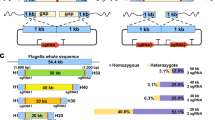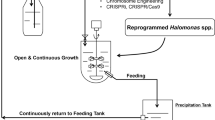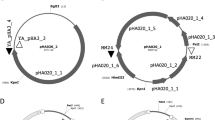Abstract
High-cell-density cultivation is an effective way to improve the productivity of microbial fermentations and in turn reduce the cost of the final products, especially in the case of intracellular products. Halomonas bluephagenesis TD01 is a halophilic platform bacterium for the next generation of industrial biotechnology with a native PHA synthetic pathway, able to grow under non-sterile continuous fermentation conditions. A selection strategy for mutant strains that can grow to a high cell density was developed. Based on an error-prone DNA polymerase III ε subunit, a genome-wide random mutagenesis system was established and used in conjunction with an artificial high cell density culture environment during the selection process. A high-cell-density H. bluephagenesis TDHCD-R3 obtained after 3 rounds of selection showed an obvious enhancement of resistance to toxic metabolites including acetate, formate, lactate and ethanol compared to wild-type. H. bluephagenesis TDHCD-R3-8-3 constructed from H. bluephagenesis TDHCD-R3 by overexpressing an optimized phaCAB operon was able to grow to 15 g/L cell dry weight (CDW) containing 94% PHA in shake flask studies. H. bluephagenesis TDHCD-R3-8-3 was grown to more than 90 g/L CDW containing 79% PHA compared with only 81 g/L with 70% PHA by the wild type when incubated in a 7-L fermentor under the same conditions.







Similar content being viewed by others
References
Alper H, Moxley J, Nevoigt E, Fink GR, Stephanopoulos G (2006) Engineering yeast transcription machinery for improved ethanol tolerance and production. Science 314:1565–1568. https://doi.org/10.1126/science.1131969
Auriol C, Bestel-Corre G, Claude J-B, Soucaille P, Meynial-Salles I (2011) Stress-induced evolution of Escherichia coli points to original concepts in respiratory cofactor selectivity. Proc Natl Acad Sci U S A 108:1278–1283. https://doi.org/10.1073/pnas.1010431108
Axe DD, Bailey JE (1995) Transport of lactate and acetate through the energized cytoplasmic membrane of Escherichia coli. Biotechnol Bioeng 47:8–19. https://doi.org/10.1002/bit.260470103
Barrick JE, Yu DS, Yoon SH, Jeong H, Oh TK, Schneider D, Lenski RE, Kim JF (2009) Genome evolution and adaptation in a long-term experiment with Escherichia coli. Nature 461:1243–1247. https://doi.org/10.1038/nature08480
Boeke JD, La Croute F, Fink GR (1984) A positive selection for mutants lacking orotidine-5′-phosphate decarboxylase activity in yeast: 5-fluoro-orotic acid resistance. Mol Gen Genet 197:345–346. https://doi.org/10.1007/BF00330984
Brynildsen MP, Liao JC (2009) An integrated network approach identifies the isobutanol response network of Escherichia coli. Mol Syst Biol 5:277. https://doi.org/10.1038/msb.2009.34
Camps M, Naukkarinen J, Johnson BP, Loeb LA (2003) Targeted gene evolution in Escherichia coli using a highly error-prone DNA polymerase I. Proc Natl Acad Sci U S A 100:9727–9732. https://doi.org/10.1073/pnas.1333928100
Carcamo M, Saa P, Torres J, Torres S, Mandujano P, Correa JRP, Agosin E (2014) Effective dissolved oxygen control strategy for high-cell-density cultures. IEEE Lat Am Trans 12:389–394. https://doi.org/10.1109/TLA.2014.6827863
Chang HN, Jung K, Lee JC, Woo H-C (2014) Multi-stage continuous high cell density culture systems: a review. Biotechnol Adv 32:514–525. https://doi.org/10.1016/j.biotechadv.2014.01.004
Chen GQ (2009) A microbial polyhydroxyalkanoates (PHA) based bio- and materials industry. Chem Soc Rev 38:2434–2446. https://doi.org/10.1039/b812677c
Chen GQ (2012) New challenges and opportunities for industrial biotechnology. Microb Cell Factories 11:111. https://doi.org/10.1186/1475-2859-11-111
Chen GQ, Hajnal I (2015) The ‘PHAome’. Trends Biotechnol 33:559–564. https://doi.org/10.1016/j.tibtech.2015.07.006
Chen GQ, Jiang XR (2018) Next generation industry biotechnology based on exremophiles. Curr Opin Biotechnol 50:94–100. https://doi.org/10.1016/j.copbio.2017.11.016
Chen K, Liu Q, Xie L, Sharp PA, Wang DI (2001) Engineering of a mammalian cell line for reduction of lactate formation and high monoclonal antibody production. Biotechnol Bioeng 72:55–61. https://doi.org/10.1002/1097-0290(20010105)72:1%3C55::AID-BIT8%3E3.0.CO;2-4
Contiero J, Beatty C, Kumari S, DeSanti C, Strohl W, Wolfe A (2000) Effects of mutations in acetate metabolism on high-cell-density growth of Escherichia coli. J Ind Microbiol Biotechnol 24:421–430. https://doi.org/10.1038/sj.jim.7000014
Ezeji T, Milne C, Price ND, Blaschek HP (2010) Achievements and perspectives to overcome the poor solvent resistance in acetone and butanol-producing microorganisms. Appl Microbiol Biotechnol 85:1697–1712. https://doi.org/10.1007/s00253-009-2390-0
Fijalkowska IJ, Schaaper RM (1996) Mutants in the Exo I motif of Escherichia coli dnaQ: defective proofreading and inviability due to error catastrophe. Proc Natl Acad Sci U S A 93:2856–2861. https://doi.org/10.1073/pnas.93.7.2856
Fu XZ, Tan D, Aibaidula G, Wu Q, Chen JC, Chen GQ (2014) Development of Halomonas TD01 as a host for open production of chemicals. Metab Eng 23:78–91. https://doi.org/10.1016/j.ymben.2014.02.006
Hellmuth K, Korz DJ, Sanders EA, Deckwer WD (1994) Effect of growth rate on stability and gene expression of recombinant plasmids during continuous and high cell density cultivation of Escherichia coli TG1. J Biotechnol 32:289–298. https://doi.org/10.1016/0168-1656(94)90215-1
Herring CD, Raghunathan A, Honisch C, Patel T, Applebee MK, Joyce AR, Albert TJ, Blattner FR, van den Boom D, Cantor CR, Palsson BØ (2006) Comparative genome sequencing of Escherichia coli allows observation of bacterial evolution on a laboratory timescale. Nat Genet 38:1406–1412. https://doi.org/10.1038/ng1906
Hiroe A, Tsuge K, Nomura CT, Itaya M, Tsuge T (2012) Rearrangement of gene order in the phaCAB operon leads to effective production of ultrahigh-molecular-weight poly [(R)-3-hydroxybutyrate] in genetically engineered Escherichia coli. Appl Environ Microbiol 78:3177–3184. https://doi.org/10.1128/AEM.07715-11
Horng YT, Chang KC, Chien CC, Wei YH, Sun YM, Soo PC (2010) Enhanced polyhydroxybutyrate (PHB) production via the coexpressed phaCAB and vgb genes controlled by arabinose PBAD promoter in Escherichia coli. Lett Appl Microbiol 50:158–167. https://doi.org/10.1111/j.1472-765X.2009.02772.x
Ibrahim MH, Steinbüchel A (2010) High-cell-density cyclic fed-batch fermentation of a poly (3-hydroxybutyrate)-accumulating thermophile, Chelatococcus sp. strain MW10. Appl Environ Microbiol 76:7890–7895. https://doi.org/10.1128/AEM.01488-10
Ienczak JL, Schmidell W, de Aragão GMF (2013) High-cell-density culture strategies for polyhydroxyalkanoate production: a review. J Ind Microbiol Biotechnol 40:275–286. https://doi.org/10.1007/s10295-013-1236-z
Ihssen J, Egli T (2004) Specific growth rate and not cell density controls the general stress response in Escherichia coli. Microbiology 150:1637–1648. https://doi.org/10.1099/mic.0.26849-0
Jiang XR, Wang H, Shen R, Chen GQ (2015) Engineering the bacterial shapes for enhanced inclusion bodies accumulation. Metab Eng 29:227–237. https://doi.org/10.1016/j.ymben.2015.03.017
Jiang XR, Yao Z-H, Chen GQ (2017) Controlling cell volume for efficient PHB production by Halomonas. Metab Eng 44:30–37. https://doi.org/10.1016/j.ymben.2017.09.004
Johnston W, Cord-Ruwisch R, Cooney M (2002) Industrial control of recombinant E. coli fed-batch culture: new perspectives on traditional controlled variables. Bioprocess Biosyst Eng 25:111–120. https://doi.org/10.1007/s00449-002-0287-8
Kato M, Bao H, Kang C-K, Fukui T, Doi Y (1996) Production of a novel copolyester of 3-hydroxybutyric acid and medium-chain-length 3-hydroxyalkanoic acids by Pseudomonas sp. 61-3 from sugars. Appl Microbiol Biotechnol 45:363–370. https://doi.org/10.1007/s002530050697
Kim JN, Ahn S-J, Burne RA (2015) Genetics and physiology of acetate metabolism by the Pta-Ack pathway of Streptococcus mutans. Appl Environ Microbiol 81:5015–5025. https://doi.org/10.1128/AEM.01160-15
Knabben I, Regestein L, Marquering F, Steinbusch S, Lara AR, Büchs J (2010) High cell-density processes in batch mode of a genetically engineered Escherichia coli strain with minimized overflow metabolism using a pressurized bioreactor. J Biotechnol 150:73–79. https://doi.org/10.1016/j.jbiotec.2010.07.006
Kocharin K, Chen Y, Siewers V, Nielsen J (2012) Engineering of acetyl-CoA metabolism for the improved production of polyhydroxybutyrate in Saccharomyces cerevisiae. AMB Express 2:52. https://doi.org/10.1186/2191-0855-2-52
Korz D, Rinas U, Hellmuth K, Sanders E, Deckwer W-D (1995) Simple fed-batch technique for high cell density cultivation of Escherichia coli. J Biotechnol 39:59–65. https://doi.org/10.1016/0168-1656(94)00143-Z
Kroll J, Steinle A, Reichelt R, Ewering C, Steinbüchel A (2009) Establishment of a novel anabolism-based addiction system with an artificially introduced mevalonate pathway: complete stabilization of plasmids as universal application in white biotechnology. Metab Eng 11:168–177. https://doi.org/10.1016/j.ymben.2009.01.007
Lee SY (1996) High cell-density culture of Escherichia coli. Trends Biotechnol 14:98–105. https://doi.org/10.1016/0167-7799(96)80930-9
Lee SY, Mattanovich D, Villaverde A (2012) Systems metabolic engineering, industrial biotechnology and microbial cell factories. Microb Cell Factories 11:156. https://doi.org/10.1186/1475-2859-11-156
Li T, Ye J, Shen R, Zong Y, Zhao X, Lou C, Chen GQ (2016) Semirational approach for ultrahigh poly (3-hydroxybutyrate) accumulation in Escherichia coli by combining one-step library construction and high-throughput screening. ACS Synth Biol 5:1308–1317. https://doi.org/10.1021/acssynbio.6b00083
Liu Y, Zhu Y, Li J, H-d S, Chen RR, Du G, Liu L, Chen J (2014) Modular pathway engineering of Bacillus subtilis for improved N-acetylglucosamine production. Metab Eng 23:42–52. https://doi.org/10.1016/j.ymben.2014.02.005
Llamas I, Quesada E, Martínez-Cánovas MJ, Gronquist M, Eberhard A, Gonzalez JE (2005) Quorum sensing in halophilic bacteria: detection of N-acyl-homoserine lactones in the exopolysaccharide-producing species of Halomonas. Extremophiles 9:333–341. https://doi.org/10.1007/s00792-005-0448-1
Luan G, Cai Z, Li Y, Ma Y (2013) Genome replication engineering assisted continuous evolution (GREACE) to improve microbial tolerance for biofuels production. Biotechnol Biofuel 6(1):137. https://doi.org/10.1186/1754-6834-6-137
Mairhofer J, Scharl T, Marisch K, Cserjan-Puschmann M, Striedner G (2013) Comparative transcription profiling and in-depth characterization of plasmid-based and plasmid-free Escherichia coli expression systems under production conditions. Appl Environ Microbiol 79:3802–3812. https://doi.org/10.1128/aem.00365-13
Meyer H-P, Leist C, Fiechter A (1984) Acetate formation in continuous culture of Escherichia coli K12 D1 on defined and complex media. J Biotechnol 1:355–358. https://doi.org/10.1016/0168-1656(84)90027-0
Montgomery K, Charlesworth JC, LeBard R, Visscher PT, Burns BP (2013) Quorum sensing in extreme environments. Life 3:131–148. https://doi.org/10.3390/life3010131
Murata M, Noor R, Nagamitsu H, Tanaka S, Yamada M (2012) Novel pathway directed by sigma E to cause cell lysis in Escherichia coli. Genes Cells 17:234–247. https://doi.org/10.1111/j.1365-2443.2012.01585.x
Ng W-L, Bassler BL (2009) Bacterial quorum-sensing network architectures. Annu Rev Genet 43:197–222. https://doi.org/10.1146/annurev-genet-102108-134304
Obruca S, Sedlacek P, Koller M, Kucera D, Pernicova I (2017) Involvement of polyhydroxyalkanoates in stress resistance of microbial cells: biotechnological consequences and applications. Biotechnol Adv. https://doi.org/10.1016/j.biotechadv.2017.12.006
Ochi K (2007) From microbial differentiation to ribosome engineering. Biosci Biotechnol Biochem 71:1373–1386. https://doi.org/10.1271/bbb.70007
Ouyang SP, Luo RC, Chen SS, Liu Q, Chung A, Wu Q, Chen G-Q (2007) Production of polyhydroxyalkanoates with high 3-hydroxydodecanoate monomer content by fadB and fadA knockout mutant of Pseudomonas putida KT2442. Biomacromolecules 8:2504–2511. https://doi.org/10.1021/bm0702307
Ouyang P, Wang H, Hajnal I, Wu Q, Guo Y, Chen GQ (2018) Increasing oxygen availability for improving poly(3-hydroxybutyrate) production by Halomonas. Metab Eng 45:20–31. https://doi.org/10.1016/j.ymben.2017.11.006
Quillaguamán J, Guzmán H, Van-Thuoc D, Hatti-Kaul R (2010) Synthesis and production of polyhydroxyalkanoates by halophiles: current potential and future prospects. Appl Microbiol Biotechnol 85:1687–1696. https://doi.org/10.1007/s00253-009-2397-6
Rehm BHA (2010) Bacterial polymers: biosynthesis, modifications and applications. Nat Rev Microbiol 8:578–592. https://doi.org/10.1038/nrmicro2354
Restaino OF, Cimini D, De Rosa M, Catapano A, Schiraldi C (2011) High cell density cultivation of Escherichia coli K4 in a microfiltration bioreactor: a step towards improvement of chondroitin precursor production. Microb Cell Factories 10:10. https://doi.org/10.1186/1475-2859-10-10
Richard H, Foster JW (2004) Escherichia coli glutamate-and arginine-dependent acid resistance systems increase internal pH and reverse transmembrane potential. J Biotechnol 186:6032–6041. https://doi.org/10.1128/JB.186.18.6032-6041.2004
Roe AJ, McLaggan D, Davidson I, O’Byrne C, Booth IR (1998) Perturbation of anion balance during inhibition of growth of Escherichia coli by weak acids. J Biotechnol 180:767–772
Salis HM, Mirsky EA, Voigt CA (2009) Automated design of synthetic ribosome binding sites to control protein expression. Nat Biotechnol 27:946–950. https://doi.org/10.1038/nbt.1568
Shiloach J, Fass R (2005) Growing E. coli to high cell density-a historical perspective on method development. Biotechnol Adv 23:345–357. https://doi.org/10.1016/j.biotechadv.2005.04.004
Silva-Rocha R, Martínez-García E, Calles B, Chavarría M, Arce-Rodríguez A, de las Heras A, Páez-Espino AD, Durante-Rodríguez G, Kim J, Nikel PI (2013) The standard European vector architecture (SEVA): a coherent platform for the analysis and deployment of complex prokaryotic phenotypes. Nucleic Acids Res 41:D666–D675. https://doi.org/10.1093/nar/gks1119
Simon R, Priefer U, Pühler A (1983) A broad host range mobilization system for in vivo genetic engineering: transposon mutagenesis in gram negative bacteria. Nat Biotechnol 1:784–791. https://doi.org/10.1038/nbt1183-784
Soetaert W, Vandamme E (2006) The impact of industrial biotechnology. Biotechnol J 1:756–769. https://doi.org/10.1002/biot.200600066
Tan D, Xue YS, Aibaidula G, Chen GQ (2011) Unsterile and continuous production of polyhydroxybutyrate by Halomonas TD01. Bioresour Technol 102:8130–8136. https://doi.org/10.1016/j.biortech.2011.05.068
Tapia F, Vázquez-Ramírez D, Genzel Y, Reichl U (2016) Bioreactors for high cell density and continuous multi-stage cultivations: options for process intensification in cell culture-based viral vaccine production. Appl Microbiol Biotechnol 100:2121–2132. https://doi.org/10.1007/s00253-015-7267-9
Trček J, Mira NP, Jarboe LR (2015) Adaptation and tolerance of bacteria against acetic acid. Appl Microbiol Biotechnol 99:6215–6229. https://doi.org/10.1007/s00253-015-6762-3
van Wegen RJ, Lee SY, Middelberg AP (2001) Metabolic and kinetic analysis of poly (3-hydroxybutyrate) production by recombinant Escherichia coli. Biotechnol Bioeng 74:70–81. https://doi.org/10.1002/bit.1096
Voss I, Steinbüchel A (2006) Application of a KDPG-aldolase gene-dependent addiction system for enhanced production of cyanophycin in Ralstonia eutropha strain H16. Metab Eng 8:66–78. https://doi.org/10.1016/j.ymben.2005.09.003
Wang F, Lee SY (1997) Production of poly (3-hydroxybutyrate) by fed-batch culture of filamentation-suppressed recombinant Escherichia coli. Appl Environ Microbiol 63:4765–4769
Wang Q, Yu H, Xia Y, Kang Z, Qi Q (2009) Complete PHB mobilization in Escherichia coli enhances the stress tolerance: a potential biotechnological application. Microb Cell Factories 8:47. https://doi.org/10.1186/1475-2859-8-47
Wang Y, Wu H, Jiang X, Chen GQ (2014) Engineering Escherichia coli for enhanced production of poly(3-hydroxybutyrate-co-4-hydroxybutyrate) in larger cellular space. Metab Eng 25:183–193. https://doi.org/10.1016/j.ymben.2014.07.010
Wang L, Chen X, Wu G, Li S, Zeng X, Ren X, Tang L, Mao Z (2015) Improved ε-poly-l-lysine production of Streptomyces sp. FEEL-1 by atmospheric and room temperature plasma mutagenesis and streptomycin resistance screening. Ann Microbiol 65:2009–2017. https://doi.org/10.1007/s13213-015-1039-8
Yin J, Fu XZ, Wu Q, Chen JC, Chen GQ (2014) Development of an enhanced chromosomal expression system based on porin synthesis operon for halophile Halomonas sp. Appl Microbiol Biotechnol 98:8987–8997. https://doi.org/10.1007/s00253-014-5959-1
Yoon SH, Han MJ, Lee SY, Jeong KJ, Yoo JS (2003) Combined transcriptome and proteome analysis of Escherichia coli during high cell density culture. Biotechnol Bioeng 81:753–767. https://doi.org/10.1002/bit.10626
Zhang H, Chong H, Ching CB, Song H, Jiang R (2012) Engineering global transcription factor cyclic AMP receptor protein of Escherichia coli for improved 1-butanol tolerance. Appl Microbiol Biotechnol 94:1107–1117. https://doi.org/10.1007/s00253-012-4012-5
Zhang X, Zhang XF, Li H-P, Wang LY, Zhang C, Xing XH, Bao CY (2014) Atmospheric and room temperature plasma (ARTP) as a new powerful mutagenesis tool. Appl Microbiol Biotechnol 98:5387–5396. https://doi.org/10.1007/s00253-014-5755-y
Zhao H, Zhang HM, Chen X, Li T, Wu Q, Ouyang Q, Chen GQ (2017) Novel T7-like expression systems used for Halomonas. Metab Eng 39:128–140. https://doi.org/10.1016/j.ymben.2016.11.007
Acknowledgements
SEVA plasmids were kindly donated by Prof. Victor de Lorenzo from the National Centre for Biotechnology in Madrid, Spain.
Funding
This study was funded by the Ministry of Sciences and Technology of China (Grant No. 2016YFB0302504), the National Natural Science Foundation of China (Grant No. 31430003 and 31600072) and the Tsinghua President Fund (Grant No. 2015THZ10).
Author information
Authors and Affiliations
Corresponding author
Ethics declarations
Conflict of interest
Yilin Ren declares that he has no conflict of interest.
Chen Ling declares that he has no conflict of interest.
Ivan Hajnal declares that he has no conflict of interest.
Qiong Wu declares that he has no conflict of interest.
Guo-Qiang Chen declares that he has no conflict of interest.
Ethical approval
This article does not contain any studies with human participants performed by any of the authors.
Rights and permissions
About this article
Cite this article
Ren, Y., Ling, C., Hajnal, I. et al. Construction of Halomonas bluephagenesis capable of high cell density growth for efficient PHA production. Appl Microbiol Biotechnol 102, 4499–4510 (2018). https://doi.org/10.1007/s00253-018-8931-7
Received:
Revised:
Accepted:
Published:
Issue Date:
DOI: https://doi.org/10.1007/s00253-018-8931-7




